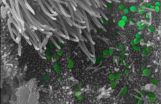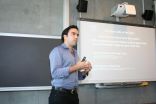Going against the flow
Targeting bacterial motility to combat disease
2014-11-18
(Press-News.org) Mycoplasma gallisepticum causes chronic respiratory disease in birds. The illness particularly affects domestic chicken and turkey flocks. The bacteria are especially life-threatening for the animals when they occur in combination with other infections. In order to control the spread of the disease, poultry farms in the EU must be proven free from Mycoplasma gallisepticum or face being closed.
Mycoplasma gallisepticum is related to the human pathogen Mycoplasma pneumoniae, the causative agent of human bronchitis and pneumonia. Mycoplasmas are among the world's smallest microorganisms. Scientists even speak of degenerative bacteria. Over the course of evolution, mycoplasmas have thrown most of their genetic material over board, resulting in one of the smallest bacterial genomes. This is what makes them such efficiently adapted pathogens in humans and animals.
At least three proteins responsible for gliding mechanism
The gliding motility of M. gallisepticum was first observed in the 1960s. However, it has so far been unclear how exactly the gliding mechanism works and which proteins make gliding possible. First author Ivana Indikova and study director Michael Szostak of the Institute of Microbiology at the Vetmeduni Vienna have now found that gliding requires the proteins GapA, CrmA and Mgc2. "If the bacteria are missing one of these three proteins, they are no longer able to move. We want to know if non-motile mycoplasmas are less infectious. If that were the case, we could target the motility genes to turn them off and so render the bacteria harmless," Szostak explains.
Gliding motility could even contribute to the ability of mycoplasmas to invade and traverse body cells. This could allow them to safely evade the body's immune system and the infection could spread efficiently through the host body.
The experts can also imagine the development of a vaccine. "Non-motile and non-pathogenic bacteria could form the basis for a new vaccine which the immune system could recognize and fight without causing any illness in the organism," explains Szostak.
Do gliding mycoplasmas go against the flow?
The ability to move thus gives the pathogens certain advantages. It remains unknown, however, which stimuli M. gallisepticum responds to when gliding. Szostak suspects: "Most mycoplasmas cannot glide. Gliding species have so far been found only in the respiratory and genital tracts - places in which there is a directional mucus flow. We believe that the gliding bacteria possibly move against this flow in order to reach deeper-lying regions of the body. We are currently planning further experiments to attempt to answer this question."
INFORMATION:
Service:
The article „First identification of proteins involved in motility of Mycoplasma gallisepticum", by Ivana Indikova, Martin Vronka and Michael P. Szostak was published in the journal Veterinary Research. DOI: 10.1186/s13567-014-0099-2 http://www.veterinaryresearch.org/content/45/1/99
About the University of Veterinary Medicine, Vienna
The University of Veterinary Medicine, Vienna in Austria is one of the leading academic and research institutions in the field of Veterinary Sciences in Europe. About 1,300 employees and 2,300 students work on the campus in the north of Vienna which also houses five university clinics and various research sites. Outside of Vienna the university operates Teaching and Research Farms. http://www.vetmeduni.ac.at
Scientific Contact:
Dr. Michael Szostak
Institute of Microbiology
University of Veterinary Medicine Vienna (Vetmeduni Vienna)
T +43 1 20577-2104
michael.szostak@vetmeduni.ac.at
Released by:
Susanna Kautschitsch
Science Communication / Public Relations
University of Veterinary Medicine Vienna (Vetmeduni Vienna)
T +43 1 25077-1153
susanna.kautschitsch@vetmeduni.ac.at
[Attachments] See images for this press release:

ELSE PRESS RELEASES FROM THIS DATE:
2014-11-18
New research by a team of European physicists could explain why the universe did not collapse immediately after the Big Bang.
Studies of the Higgs particle - discovered at CERN in 2012 and responsible for giving mass to all particles - have suggested that the production of Higgs particles during the accelerating expansion of the very early universe (inflation) should have led to instability and collapse.
Scientists have been trying to find out why this didn't happen, leading to theories that there must be some new physics that will help explain the origins of the universe ...
2014-11-18
WINSTON-SALEM, N.C. - Nov. 18, 2014 - Although every person's DNA remains the same throughout their lives, scientists know that it functions differently at different ages.
As people age, drastic changes occur in their DNA methylation patterns, which are thought to act as a "second code" on top of the DNA that can lock genes in the on or off position. However, what the consequences of these changes are remains a mystery.
To begin deciphering this process, scientists at Wake Forest Baptist Medical Center studied methylation patterns in the blood cells of 1,264 persons ...
2014-11-18
This news release is available in German.
Are the fundamental constants really constant? Recent investigations carried out at the Physikalisch-Technische Bundesanstalt (PTB) have shown that one essential fundamental constant - namely the mass ratio of protons to electrons - can have changed only by a maximum of one part in a million over the age of our solar system (i.e. extrapolated over approx. 5 billion years). Previously, scientists deemed the possible changes to be twice as high. To obtain this result, physicists from PTB compared caesium and ytterbium atomic ...
2014-11-18
Spices and herbs are rich in antioxidants, which may help improve triglyceride concentrations and other blood lipids, according to Penn State nutritionists.
Triglyceride levels rise after eating a high-fat meal -- which can lead to an increased risk of heart disease. If a high-antioxidant spice blend is incorporated into the meal, triglyceride levels may be reduced by as much as 30 percent when compared to eating an identical meal without the spice blend. The spiced meal included garlic powder, rosemary, oregano, cinnamon, cloves, paprika, turmeric, ginger and black pepper.
Sheila ...
2014-11-18
Scientists have discovered how a gene mutation can lead to diseases that occur when the immune system attacks the body by mistake.
Understanding how these mechanisms work could help scientists to develop new treatments for autoimmune diseases such as Lupus and neurodegenerative conditions including Motor Neurone Disease.
Researchers found that a mutation in the gene - called ADAR1 - causes a defect in an alarm system in our cells that normally protects the body from viruses and other infections. This means that the alarm system is tripped by the cell's own molecules, ...
2014-11-18
A new method for examining the Ebola virus genome could make surveillance quicker and cheaper for West African nations, and help detect new forms of the virus. The detailed procedure is being shared with the research community along with the study paper, which is freely available in the open access journal Genome Biology.
With over 13,000 cases and nearly 5,000 deaths in eight affected countries, the current Ebola outbreak in West Africa is the largest to date, the first to spread to densely populated urban areas, and represents the first time the virus has been diagnosed ...
2014-11-18
Celiac disease patients suffer from gluten intolerance and must adjust to a life without gluten from food sources like wheat, rye and barley. There is no treatment of the disease except lifelong gluten-free diet, but now a Danish/Norwegian research team publishes new research, that may lead to the development of a drug against the disease.
Gluten intolerance is often caused by celiac disease, which makes the human organism sensitive to gluten proteins from certain cereals. No known drug can cure the disease or make the patient able to eat gluten again, and therefore the ...
2014-11-18
A new study has shown for the first time how people can be trained to "see" letters of the alphabet as colours in a way that simulates how those with synaesthesia experience their world.
The University of Sussex research, published today (18 November 2014) in Scientific Reports, also found that the training might potentially boost IQ.
Synaesthesia is a fascinating though little-understood neurological condition in which some people (estimated at around 1 in 23) experience an overlap in their senses. They "see" letters as specific colours, or can "taste" words, or ...
2014-11-18
Researchers at the Bellvitge Biomedical Research Institute (IDIBELL) and doctors at University Hospital of Bellvitge, together with a team of researchers from the University of California, Cincinnati Children's Hospital, California Pacific Medical Center, University of Pittsburgh, University Emory and Stanford University (USA) and the Children's Hospital of Mexico Federico Gomez, have developed a genetic test that identifies patients at high risk of kidney transplant rejection. From a peripheral blood sample and test development easier, you can tell noninvasively and before ...
2014-11-18
For years physicists have been looking for the universe's elusive dark matter, but so far no one has seen any trace of it. Maybe we are looking in the wrong place? Now physicists from University of Southern Denmark propose a new technique to detect dark matter.
The universe consists of atoms and particles - and a whole lot more that still needs to be detected. We can only speculate about the existence of this unknown matter and energy.
"We know that app. 5 pct. of the universe consists of the known matter we are all made of. The rest is unknown. This unknown matter ...
LAST 30 PRESS RELEASES:
[Press-News.org] Going against the flow
Targeting bacterial motility to combat disease


